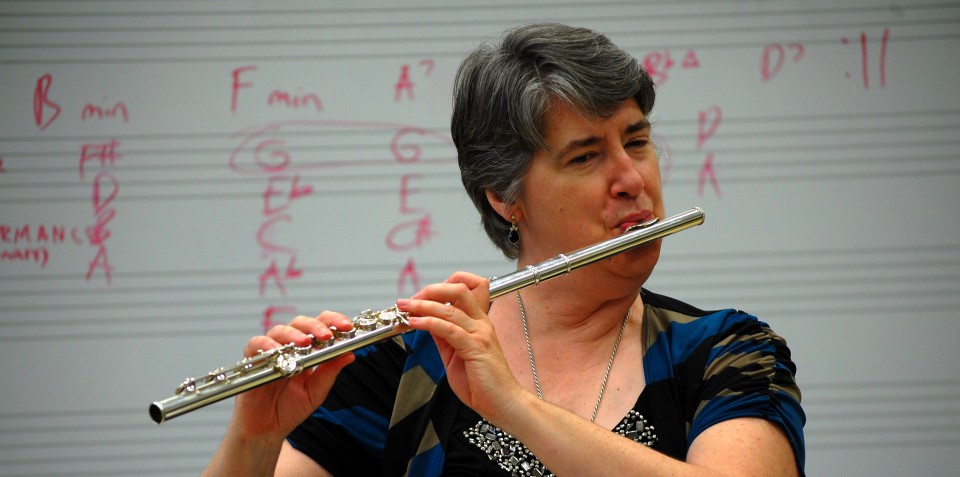Having strength and flexibility in the lips are the most necessary requirements for a good flute embouchure. If you have these, you can generate the necessary resistance to make a strong, characteristic tone. You can shape and direct the air to change register, correct pitch, and shade and color the tone.
In most cases, a having a tear drop top lip will not prevent a student from developing a directed air stream. It’s just a matter of helping the student to learn to shape the aperture to one side or the other of the tear drop, though to the left (toward the crown) is generally more desirable. I have known students who have done either way successfully. However, occasionally there are sometimes cases with the shape or flexibility of the lips where it might be better to steer a student away from the flute because there is some physical limitation. Here’s an example from a parent’s comment left on the post “What do you do with your corners?“.
My daughter is 12 and just learning the flute in band 7. She is having the toughest time getting the flute to make any noise. She has been told not to pucker her lips but isn’t puckering the shape you describe by sucking on a straw? She can only get a tone when puckering but having to blow really hard. She was also born with a cleft palate and after the repair as a baby her palate is shaped differently then a typical palate with a lot of bumps and creases. She also has a overbite. Would any of these issues be making it difficult to make her flute play? She has been trying for about a month with little improvement. Should we keep trying or switch instruments?
And here is my response:
You ask some really good questions. It is going to be difficult to diagnose and make recommendations for your daughter based on a written description. My guess is that because of her cleft palate repair, your daughter might have less flexibility in her top lip than is typical. This might be the cause of her having trouble shaping an aperture with her lips. Having an overbite shouldn’t be an issue. I have an overbite. In fact, I think an overbite might be an advantage to some degree.
It’s hard to say for sure what is going on for this child, though, as I said in my reply, my best guess is that the cleft palate repair has left the girl with less than normal flexibility in her top lip. In this case, it might be a better choice to steer her toward another instrument, even a non-wind instrument. Having said that though, you will occasionally encounter a kid that is so determined to play flute, they will work at developing an embouchure with breathtaking perseverance despite what seems like an insurmountable physical obstacle. In that case I say let them work at it (with proper guidance) and decide for themselves whether they want to persist until they succeed or decide try another instrument.
If you find these entries useful, please subscribe, share with your colleagues and come back regularly. Feel free to comment. If you have a topic you would like to see explored more fully, you can contact me via IM/Messenger on Facebook or email me at dr_cate@sbcglobal.net. For information about clinics, workshops and performances, click here.

I have a new student with a slight overbite who struggles with playing in the third register (tone is airy and loud!). She was used to aligning her headjoint quite far out, which made her flute rock backwards. I have her using the traditional tone hole/first key setup, and now her keys are parallel, but I’m wondering if this new alignment is causing her trouble. I’m not sure how to help a student with an overbite.
LikeLike
Have her try putting the flute a little lower on her chin and roll the entire flute out slightly with the blow hole lined up between the keys and the rods. The blow hole should be open 2/3 to 3/4 in order to get the best sound. An overbite is actually an advantage playing the flute. The converse, an underbite, is much more problematical because the whole point is to aim the airstream down toward the blowing edge. See my article, It’s All About Balance.
LikeLike
I had a surgery for cleft palate and I really want to learn the flute. Is playing the flute possible for me still? Will I be able to tongue?
LikeLike
It’s hard to say whether you could play the flute or not. It really just depends how much sensitivity and flexibility you have in your top lip. I have seen people who have had a cleft lip repaired whose top lip is rather thin where the repair was done and don’t have a lot of flexibility. This is conjecture on my part, but I would think this would limit your ability to properly shape the aperture. Having said that, though, I’ve seen people overcome huge obstacles to play because they really want to.
As for tonguing, I don’t think there would be any issue with that. More of an issue is how freely your tongue is able to move in your mouth. Were you tongue tied? I’m assuming your palate is basically solid from where the repair was done. As long as the tip of your tongue can strike at the top of your mouth, behind your teeth to say “T” or “D”, I don’t see any reason why tonguing should be an issue.
LikeLike